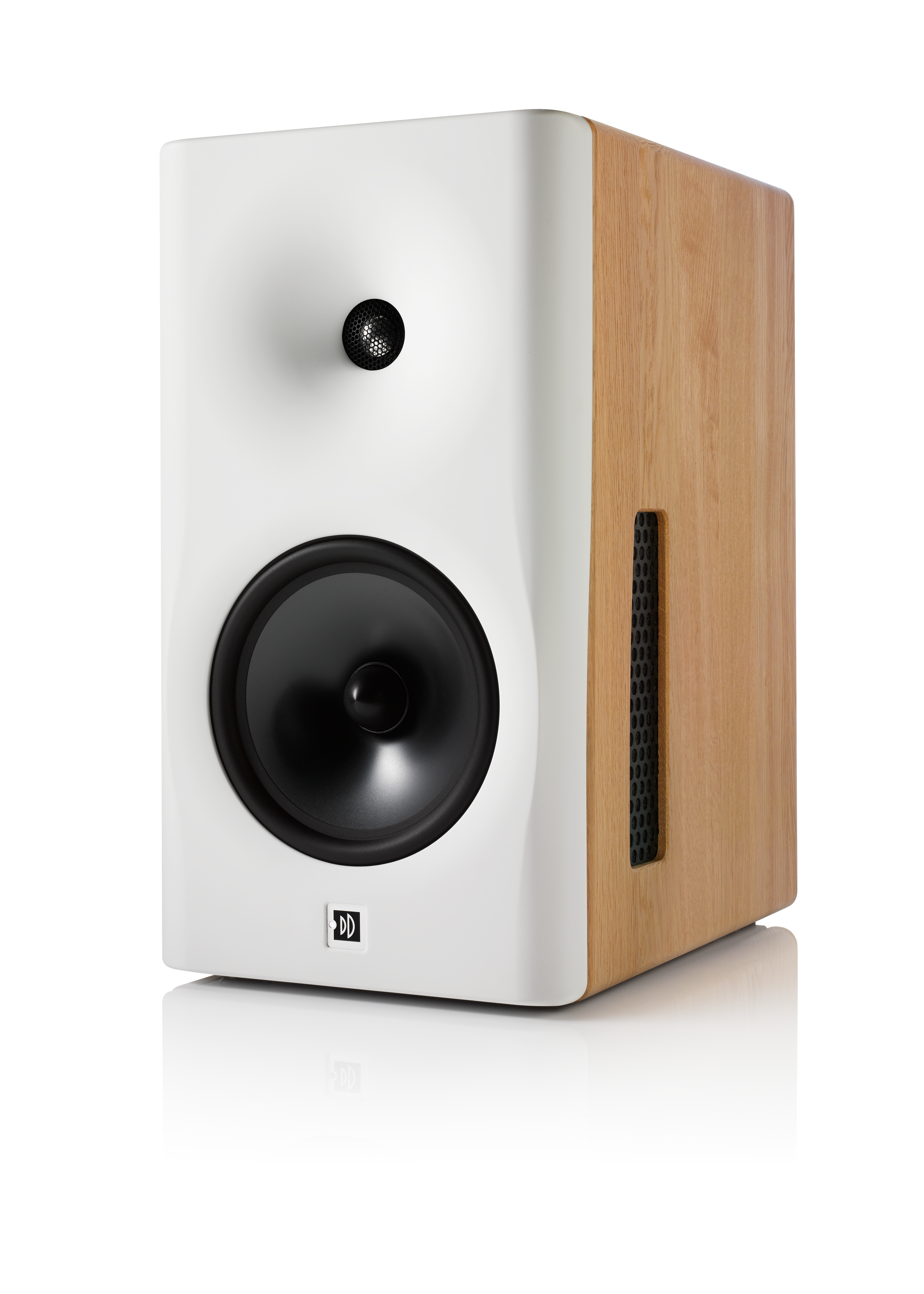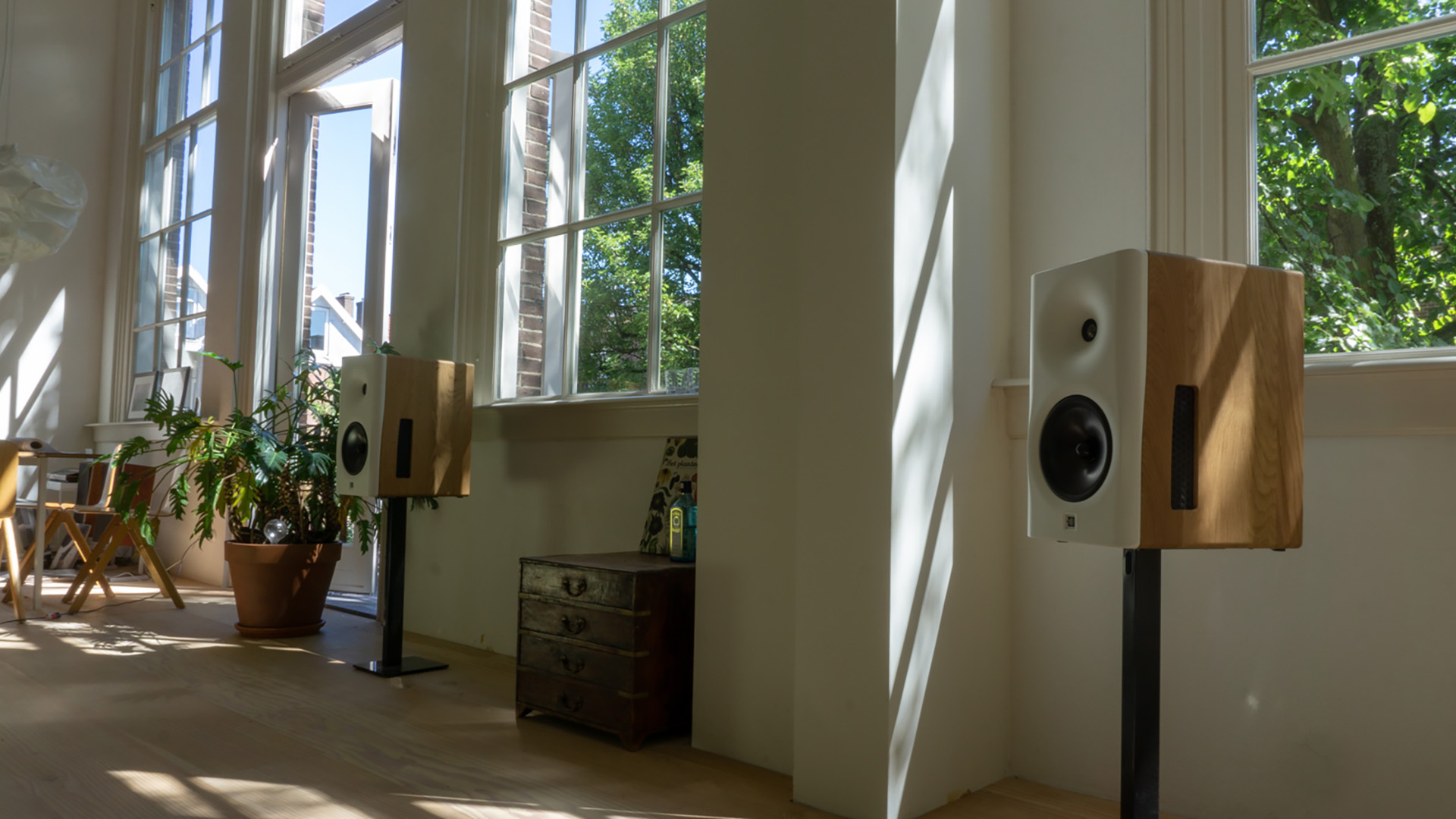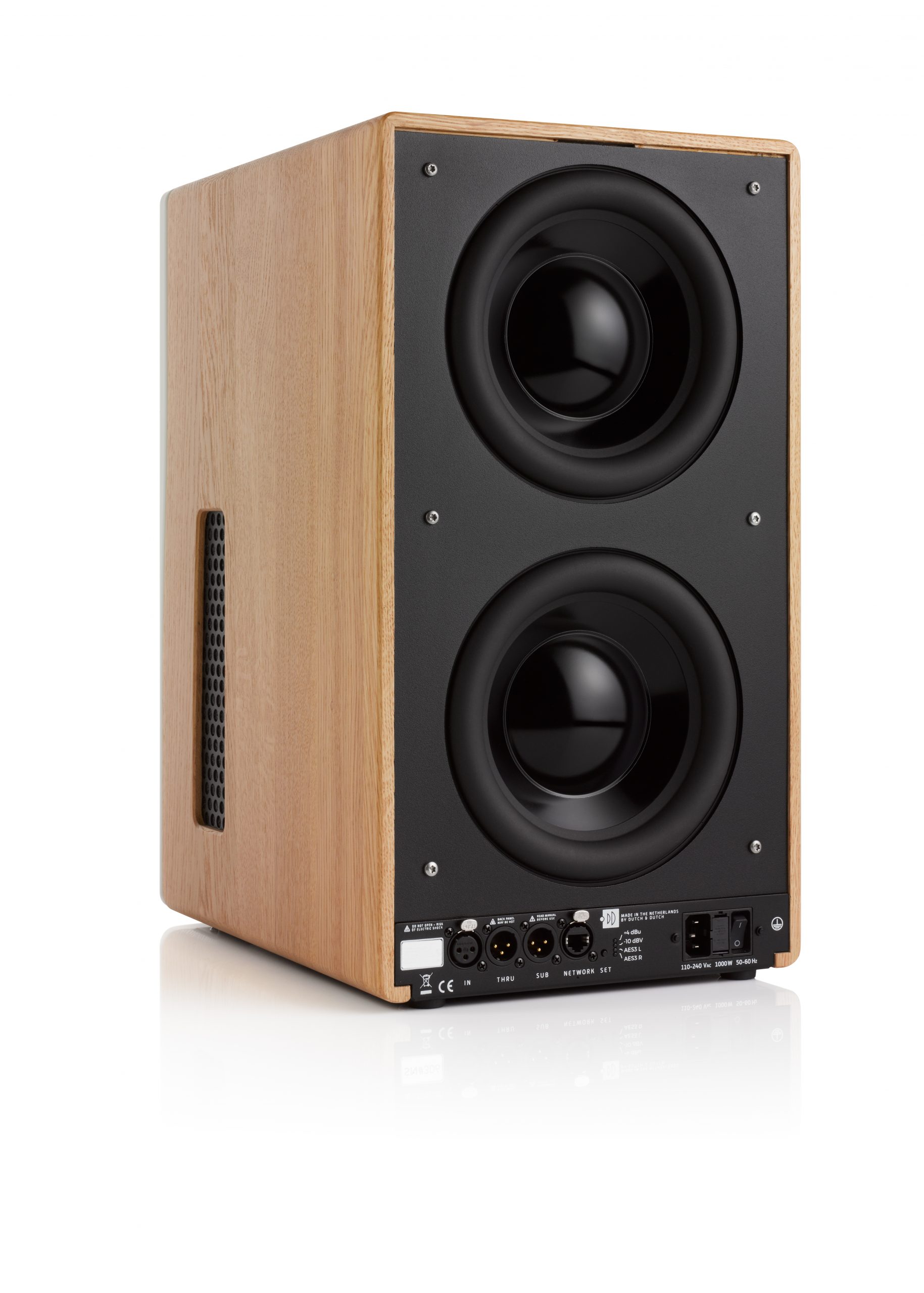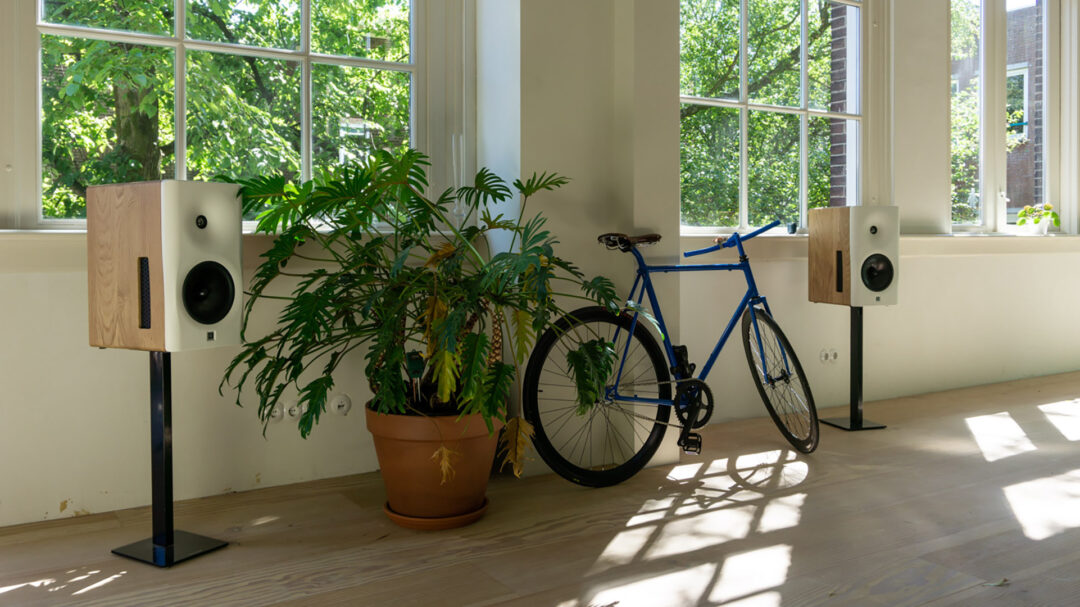Dutch & Dutch is Dutch – and so obviously proud of their heritage that they chose to mention it twice in the company name. The company, which is based in Rotterdam, has only one product on the program, a speaker. It is, in turn, brimming with interesting technical solutions.
First of all, it is active and completely digital. This means that the integrated amplifiers can be developed for the speaker units used. And that frequency response and phase ratios can be controlled accurately. It also means you don’t have to find space – and budget – for a heavy league high-end amplifier.
Dutch & Dutch 8c is a rather big standmount speaker of almost half a meter in height. It is best placed on the associated stands and, due to its design principle, it must under no circumstances be placed on a shelf. Which is also not much of an option due to the size.
The speaker immediately looks like a two-way with an 8-inch midwoofer and a dome tweeter on the front. The diaphragm of the tweeter is made of an aluminum-magnesium alloy and the driver is placed in a large waveguide milled into the softly rounded front of lacquered MDF. The two units are each powered by a 250 watt class D amplifier.
But thar is only half of it. At the back of the speaker you will find two more long stroke 8-inch woofers units with aluminum diaphragm. They cover the range between approx. 30 Hz and 100 Hz.

Genuine wood
The cabinet itself is both professionally and technically interesting. The lovely oak finish is not veneer; the cabinet is built of 20 mm thick, solid oak boards. The result is both nice and acoustically very quiet.
While the (sub-) bass drivers, which are driven by a 500 watt class D amplifier, work in a closed cabinet, the midwoofer is placed in a semi-open cabinet, which via two “gill openings” on the sides acts as a kind of acoustic dipole.

Here it is appropriate to repeat a little acoustic basic knowledge: The oldest “cabinet type” was open baffle, ie where the speaker unit is mounted on a plate, but otherwise plays freely. A method that in recent times has regained interest in some audiophile circles. One of the properties of the open baffle is that the radiation to the sides is limited, as sound in opposite phase from the back of the diaphragm meets the sound from the front, which is thus phased out.
Easy to place in the living room
And what does that mean in practice? This means that the sound from Dutch & Dutch 8c is far more directional than the sound from other speakers. Thanks to the waveguide in the treble and the open cabinet in the middle bass, they have managed to keep the radiation pattern from the speaker constant and relatively narrow in the entire frequency range from 100 Hz and up.
It provides a speaker that is quite easy to place in the room as it is not disturbed by reflections from walls, floor and ceiling to the same degree as most other speakers. Below 100 Hz, where the two subwoofers on the back play, Dutch & Dutch 8c are all around as normal speakers are in the bass range.
For professionals
Dutch & Dutch 8c is a speaker for home use, but you can buy a version for monitor use in sound studios that is identical, except for the cabinet finish and a built-in ceiling bracket.
The connections are also similar to what you find on a professional product. All connections are professional XLR sockets, and the product is characterized by being created for technically savvy users – or users who have the speakers set up and adjusted upon delivery.

The setup of Duch & Dutch 8c is a bit unusual, but otherwise works quite smoothly. The speakers must in turn be connected to the network with cable, whereupon in a browser you can adjust the frequency response according to the distance to the back wall and side walls.
The built-in DSP can also be used for EQ adjustments as well as room correction. But in that case, it happens through third-party programs, and it is by no means a simple, automated task. Neither a measuring microphone nor streamlined mobile apps are included for the purpose.
Requires regulated digital signal
The input sockets can be used either as direct digital (AES/EMU) or as analog input. You can use the speaker well with any analog preamplifier. But to get the shortest signal path without redundant conversions back and forth between the analog and digital domains, we used the input digitally.
Here, however, one must be aware that the source – e.g. a media streamer – must provide a signal where the volume can be adjusted in the digital domain. Something that is far from usual. The speakers themselves have no controls at all; be it in the form of volume control or management app. Wireless connection and built-in streaming services do not need to be set up either. This is a pure active speaker!
With the speakers configured and set up in the living room, connected to a Lumin streaming receiver with variable digital output, the listening test could begin.

The sound quality
The sound of Dutch & Dutch 8c matches the professional impression of the physical appearance. This is about revealing all the details of the recording with the least possible staining. If you are looking for a speaker with a warm and musical sound or a rock speaker with concert sound, you might as well scroll on right away!
With a frequency response that is ruler-straight between 30 Hz and 20 kHz, it is not surprising that it also sounds neutral in the sense that no tonal ranges are highlighted or suppressed. It may well give a slightly dull or unimpressive first impression.
The fact that the middle bass is thus not highlighted to give a warm sound does not mean that Dutch & Dutch 8c is lacking in bass. On the contrary. Not many speakers of that size are able to keep the full sound level down to 30 Hz, and you can detect room resonances that you had no idea existed. Only bass enthusiasts will find reason to also use the subwoofer output on the speakers!
Revealing
The bass is not only powerful but also precise. Rapid impulses such as timpani strokes start and stop abruptly, and it is easy to separate the deep instruments. Like on Zhao Cong and Hans Nielsen’s “Moon Light on Spring River”, where large temple drums are mixed with deep synthesizer bass.
On the same recording, one also easily hears that the track consists of a patchwork of live recordings and other soundtracks added in the Focus Recordings studio in Vanløse (and still others in Prague). Something that on more forgiving speakers and amplifiers gathers into one big and evocative acoustic scene. But as on speakers with monitor properties the trusth is revealed.
A monitor speaker must be able to detect faults, and so does Dutch & Dutch 8c. Voices and details in the treble are reproduced with all the resolution you could ask for. But it does not overfocus on errors to a degree, so it becomes a pain to hear less successful recordings.

Wide and tall
At the same time, one must praise Dutch & Dutch 8c for their ability to paint up the acoustic scene – when there is a coherent one present in the recording. The stage extends both higher and wider than the boundaries of the listening room. Part of the explanation may be that the speakers disperse the sound less and thus avoid some of the disturbing reflections from the room.
However, the depth perspective is not so overwhelming. There is nothing wrong, and you can easily sense the stage stretching deep behind the speakers. But the placement of the instruments in depth and the feel of the walls in the recording room is not as razor sharp as on the best passive speakers in the same price range. And also not as on the equally active and somewhat cheaper DALI Rubicon 6 C.
We’re down to the small details here, and it’s ultimately more about prioritizing attributes than about good versus bad. But at such a dramatic price, one can make great demands.

Conclusion
Dutch & Dutch 8c is a different speaker from a relatively unknown manufacturer, and it even costs an awful lot of money. But it costs to buy a professional tool with razor-sharp precision – and the power to play up the living room or control room.
With their ability to remove the back wall of the living room and paint an acoustic scene that is both taller and wider than the physical surroundings, while revealing even small details uncoloured, the unique Dutch place themselves in an exclusive class. A class where it is perfectly normal for a set of speakers to cost the same as a (cheap) car. You must also keep in mind that you get an excellent digital converter and three power amplifiers with a total power of 1000 watts per. channel included in the price.
Where, on the other hand, something is missing is on the usability. Even in the high-end world, wireless connectivity and app management are becoming commonplace.

We think
Beautiful craftsmanship. Unusually naked and sober rendering. Easy to place thanks to a completely original construction. Costs quite a lot of money. Speaks more to the intellect than to the emotions. No wireless connection available.
8995 €
Specifications
- Configuration: 2 x 8″ woofer, 8″ midwoofer, 1″ magnesium dome tweeter
- Construction principle: Closed/semi-open 3-way, active
- Frequency range: 30 Hz – 20 kHz (+/- 1 dB)
- Built-in amplifier power: 1 x 500 + 2 x 250 W class D in each speaker
- Crossover: 100 Hz, 1250 Hz, 4th order digital, phase linear
- Connections: Analog balanced (XLR), digital AES (XLR), Ethernet (RJ45), subwoofer (XLR)
- Dimensions and weight: 27 x 48.5 x 38 cm / 26 kg
- Finish: Massive oak
- Web: dutchdutch.com


“Speaks more to the intellect than to emotions” — is a huge compliment. So it doesn’t colour sound like a market pleasing Bose or B&O or Klipsch. Got it 🙂
“The speakers themselves have no controls at all; be it in the form of volume control or management app.”
How uneducated can a reviewer be? The D&D 8C has always had volume control and management including advanced room correction from their App called Ascend Audio (download to iPhone, Android Phones, .
iPad, computer etc).